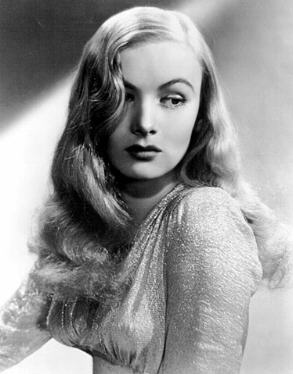Veronica Lake (Veronica Lake)

Veronica Lake
Actress. Known for her peek-a-boo hairstyle, she is probably best remembered for her role in “Sullivan’s Travels” (1942) and for her femme fatale roles in film noirs with Alan Ladd, during the 1940s. Her career spanned five decades, from films, to stage, and television beginning in 1939 until 1970. Born Constance Frances Marie Ockelman, her father worked for an oil company aboard a ship. When she was 10 years old, her father was killed in an explosion. Her mother then married a newspaper artist and they lived in Saranac Lake, New York, where she attended St. Bernard’s School for a time, then was sent to Villa Maria, an all-girls Catholic boarding school in Montreal, Canada, from which she was expelled. She then moved with her family to Miami, Florida, where she attended Miami High School. In 1938 she moved with her family to Beverly Hills, California and enrolled in the Bliss-Hayden School of Acting (now the Beverly Hills Playhouse) and began working in films as an extra. Her first appearance on screen was for RKO Pictures, playing a small role among several coeds in the film “Sorority House” (1939). Similar roles followed, including “All Women Have Secrets” and “Dancing Co-Ed” (both 1939). Her breakthrough role came two years later in the World War II drama “I Wanted Wings” (1941). The film was a major hit in which she played the second female lead. During the filming of the movie, she developed her signature look when her long blonde hair accidentally fell over her right eye during a take and created a “peek-a-boo” effect. The hairstyle became her trademark and was widely copied by women. She followed up with starring roles in more popular movies, including “Sullivan’s Travels” (1942), “This Gun for Hire” (1942), “I Married a Witch” (1942), and “So Proudly We Hail!” (1943). It was later during World War II that she changed her trademark peek-a-boo hairstyle at the urging of the government to encourage women working in war industry factories to adopt more practical, safer hairstyles. While the change helped to decrease accidents involving women getting their hair caught in machinery, doing so may have been detrimental to her career. She became known for onscreen pairings with actor Alan Ladd, beginning with the “This Gun for Hire.” Initially, the couple was teamed together merely out of physical necessity, as Ladd was just 5 feet 5 inches tall and she, at 4 feet 11 and 1/2 inches tall, was the only actress at Paramount short enough to pair with him. They became a popular onscreen duo and would make other films together, including the films noir “The Glass Key” (1942), “The Blue Dahlia” (1946), and “Saigon” (1948). Her career began to falter with her unsympathetic role as Nazi spy ‘Dora Bruckman’ in “The Hour Before the Dawn” (1944). Reviews of the film included criticism of her unconvincing German accent. To boost her career, Paramount Studios tried her in a series of 1945 comedies, “Bring on the Girls,” “Out of This World,” “Duffy’s Tavern,” and “Hold That Blonde” followed by “Miss Susie Slagle’s” (1946) and “The Sainted Sisters” (1948), but few were successful. In 1948 Paramount Studios did not renew her contract and after a single film for 20th Century Fox, “Slattery’s Hurricane” (1949), her career began to wane. By the end of 1951 she had appeared in one last film, “Stronghold.” That same year, she filed for bankruptcy and the Internal Revenue Service later seized their home for unpaid taxes. She then left Hollywood and moved to New York. As a result of her disillusionment with Hollywood and not liking what it did with people, she decided to restart her career. Wanting to leave her sexy image behind, New York offered the opportunity to work in theater and the new medium, television. Her stage credits include “The Voice of the Turtle” (Atlanta, February 1951), “The Curtain Rises” (Olney Theatre, Olney, Maryland, 1951), “Peter Pan” (road tour, 1951), “Gramercy Hill” (1952), and “The Little Hut” (Detroit, 1955). Her television credits include “Lights Out” (1950), “Somerset Maugham TV Theatre” (1951), “Goodyear Playhouse” (1952), “Danger” (1953), and Broadway Television Theater” (1954). Afterwards, she drifted between cheap hotels in New York City, and was arrested several times for public drunkenness and disorderly conduct. In 1962 a New York Post reporter found her working as a barmaid at the all-women’s Martha Washington Hotel in Manhattan, leading to speculation that she was destitute. In 1966 she had a brief stint as a television hostess in Baltimore, Maryland, along with a largely ignored film role in “Footsteps In the Snow.” Four years later, she released her memoirs, “Veronica: The Autobiography of Veronica Lake” and used the money she made from the book to finance a low-budget horror film “Flesh Feast” (1970) her final onscreen appearance. In June 1973, while traveling in Vermont, she was admitted to a hospital, complaining of stomach pains. She was discovered to have cirrhosis of the liver and she died shortly afterwards from hepatitis and acute kidney injury at the age of 50. She was one of the models for the animated character ‘Jessica Rabbit’ in the film “Who Framed Roger Rabbit?” (1988), especially for her hairstyle. She has a star on the Hollywood Walk of Fame for her contributions to films. (bio by: William Bjornstad) Family links: Spouses: John Stewart Detlie (1908 – 2005) André de Toth (1912 – 2002) Joseph A. McCarthy (____ – 1969) Children: Andre Anthony Michael De Toth (1945 – 1991)* *Calculated relationshipCause of death: Hepatitis
Born
- November, 14, 1922
- Brooklyn, New York
Died
- July, 07, 1973
- Burlington, Vermont
Cause of Death
- Hepatitis
Cemetery
Other
- Cremated

